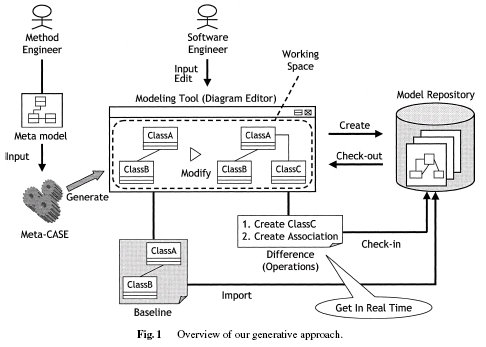Version Controlling Software Diagrams
這幾天同時在忙著跟不同的人合作不同的 project, 剛好都需要建立 design diagrams. 而由於許多前期分析的文件彼此都會修改, 因此早早就用 Subversion 管理這些文件. 而在建立 design diagrams, 忽然想到一個問題 : 怎樣對於 design diagrams 作 version control ?
當然很直覺的, 既然 design diagrams 通常也是一個一個的檔案, 就跟 source code file 一樣管理不就好了 ? 事情當然沒這個單純.
通常一張 design diagram 內包含許多 elements, 例如可能有 10 個以上的 classes, 以及各種 associations. 在 source code level 中, 這些 classes 的 code files 很可能是分開的, 因此不同的 developers 要同時修改不同的 classes 可以很容易的透過 version control 達成. 但是如果今天是在同一張 design diagram 中呢 ? version control 基於本身 data model 的限制, 大概就無法直接幫上忙.
更甚者, 許多 design tools 習慣把一個 project 內的所有 diagrams 包在同一個儲存檔案, 例如 ArgoUML 就用 .zargo 把相關 diagrams 都壓縮在一起. 對於 version control system 來說, 這就只會是一個要管理的檔案, 然而對於使用者 (developer) 來說, 所面對的卻是不同的 diagram 檔案. 在這兩者之間產生了落差.
解決的方法很容易地可以想到幾種, 大多會需要把一張 design diagram 拆開來管理, 例如利用 XMI 來撰寫 design diagram, 然後把 XML elements 拆開來作 version control. 或是在儲存到 version control system 內的時候, 把壓縮起來的檔案解開儲存. 或是乾脆在儲存一張 diagram 時, 就是分開成數個 diagram elements 儲存, 例如 classes 跟 associations.
不過找了找 free / open source design softwares, 好像沒有具備此種 features 的 tools, 是否大家都沒有此種需要呢 ? 但是在 Mandar Chitnis 等人的 UML Tools 文章 [1] 中, 有提到此項 feature, 引用部份內容 :
Version control: A very important feature that we want to have in the UML tool is either an integrated version control mechanism or connectivity to a standard version control system. Configuration management is an integral part in the building of software systems. Considering that the design of a system is a very important artefact of the software lifecycle, maintaining versions and baselines of the system design is a desirable feature to have in UML tools. In the absence of direct support for version control, it is the responsibility of the designer to maintain versions of the design.
又找了找學術界的部份, 發現有兩篇 papers 討論了這個問題. 第一篇是 H. Oliveira 等人的研究 [2] , 使用 XMI 為儲存基礎. 在 Client 端的 UML IDE tool 以 XMI 輸出 design diagram, 透過 Server 端提供的 web interface 對於 XMI 檔案作必要的處理, 再利用 version control system 儲存. Client 端理論上應該可以使用不同的 UML IDE tools, 但是現實是各家 tools 的 XMI 輸出還是存在 mismatch, 因此很可能還是必須使用同樣的 UML IDE tool.
第二篇是 Takafumi Oda 等人的研究 [3], 這篇採用的是不同的作法, 將 software engineer 的編輯動作分解成為單一動作 ( atomic change), 然後編輯時 real-time 記錄下來. 在 check-in 時是紀錄這些動作, 作為 model 改變的代表 ( differences ). 在最初使用時需要 import 一個最初版本的 design diagram ( design model ) 作為 baseline, 而後進行 check-out 時, 是依據這個 baseline 加上中間紀錄的動作, 得到最後的 latest diagram or model ( 或是得到特定版本的 ) . 這個作法的缺點之一是目前的 UML IDE tool 顯然需要作比較多的修改才能配合, 同時如果希望各家 IDE 可以共享 diagram 的話, 還需要制定一個標準給各家公司遵守.
References :
[1] Mandar Chitnis, Pravin Tiwari, & Lakshmi Ananthamurthy, "UML Tools," developer.com, URL : http://www.developer.com/design/article.php/1593811
[2] Hamilton Oliveira, Leonardo Murta, and Cláudia Werner, "Odyssey-VCS: A Alexible Version Control System for UML Model Elements," Proceedings of the 12th International Workshop on Software Configuration Management, pp.1-16, 2005, pdf download here or here (ACM)
[3] Takafumi Oda and Motoshi Saeki, "Meta-Modeling Based Version Control System for Software Diagrams," IEICE Transactions on Information and Systems, vol.4, pp.1390-1402, 2006, pdf download here

0 意見:
張貼留言